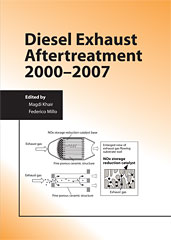Video

Characterization of a New Advanced Diesel Oxidation Catalyst with Low Temperature NOx Storage Capability for LD Diesel
2012-06-18
A 2007 Cummins ISL 8.9L direct-injection common rail diesel engine rated at 272 kW (365 hp) was used to load the filter to 2.2 g/L and passively oxidize particulate matter (PM) within a 2007 OEM aftertreatment system consisting of a diesel oxidation catalyst (DOC) and catalyzed particulate filter (CPF). Having a better understanding of the passive NO2 oxidation kinetics of PM within the CPF allows for reducing the frequency of active regenerations (hydrocarbon injection) and the associated fuel penalties. Being able to model the passive oxidation of accumulated PM in the CPF is critical to creating accurate state estimation strategies. The MTU 1-D CPF model will be used to simulate data collected from this study to examine differences in the PM oxidation kinetics when soy methyl ester (SME) biodiesel is used as the source of fuel for the engine.

